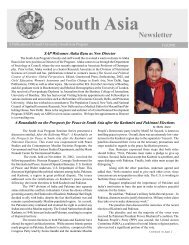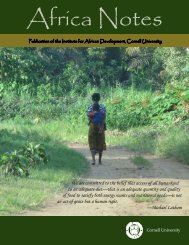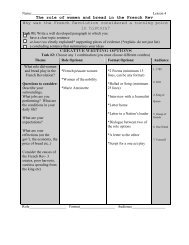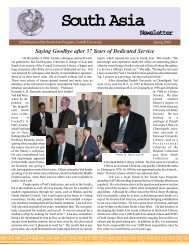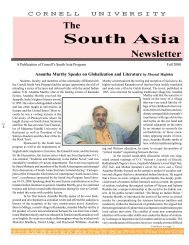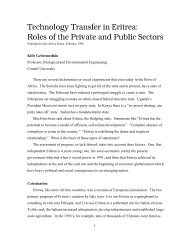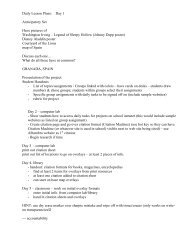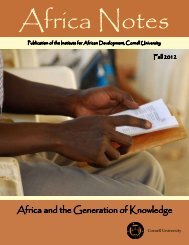Outline - Southeast Asia Program - Cornell University
Outline - Southeast Asia Program - Cornell University
Outline - Southeast Asia Program - Cornell University
You also want an ePaper? Increase the reach of your titles
YUMPU automatically turns print PDFs into web optimized ePapers that Google loves.
Alexandra DenesPhD Candidate, <strong>Cornell</strong> <strong>University</strong>Freeman Workshop PresentationElephants in <strong>Southeast</strong> <strong>Asia</strong>I. Introduction: The Elephant as a “Key Symbol” (Ortner 1973)Anthropologists have long made use of “key symbols” as a means of understandingthe different cultures in which they study. As explained by the first anthropologist tocoin this term, Sherry Ortner, the identification and interpretation of a culture’s “keysymbols” are central to the anthropological project because key symbols can be saidto encapsulate or “summarize” the system of beliefs and values of any given society.By interpreting key symbols, one can uncover a kind of structural blueprint of asociety’s norms and values. But as a newcomer to a culture, how can we learn todistinguish a key symbol from the myriad signs and symbols that suffuse popularmedia and public spaces? Ortner offers several criteria for determining whether asymbol can be classified as a key symbol. We know if something is a key symbol if:1. Local people tell us X is important.2. Local people are positively or negatively aroused by X, rather than beingindifferent to it.3. We find X in many contexts in the culture—it seems to be represented over andover again in many different domains, including art, ritual, and formal rhetoric.4. Relatedly, cultural elaboration surrounds X; there is a rich vocabulary available totalk about it and lots of images associated with it.5. There may be rules surrounding X—taboos about its use or representation.As we shall see in the discussion that follows, all of these criteria can be applied tothe figure of the elephant in <strong>Southeast</strong> <strong>Asia</strong>. By undertaking an interpretive study ofthe elephant as a key symbol in this presentation, our goal is to show how theelephant offers insights into many facets of <strong>Southeast</strong> <strong>Asia</strong>n culture and society,including mythology, religion, politics, arts, and the changing relations betweenhuman populations and their natural environments in the modern era.In terms of my presentation today, the majority of my discussion will focus on theelephant in Thailand, as this is where I have spent most of my time as a student andresearcher. My own interest in elephants stems from fourteen months of field researchin Surin between 2000-2003—a province of approximately 1.3 million inhabitantslocated in Thailand’s Northeast. Surin is widely known for its annual ElephantRound-up and its long history of elephant catching by the region’s ethnic Kui, whotraveled to Cambodia to capture elephants in the wild before the closure of the border
in 1960. As we shall see, the myths, rituals, and taboos surrounding the figure of theelephant in Surin are indicative of the symbolic meanings of elephants in Thailandand <strong>Southeast</strong> <strong>Asia</strong> at-large.II.The Elephant in Hindu-Buddhist Myth, Religion, and ArtAs stated previously, one of the means of distinguishing a key symbol is to payattention to the context and frequency of its appearance. In the case of Thailand, itwould not take the first-time visitor very long to realize that the elephant is a keysymbol, as its symbolic representation is virtually ubiquitous in both official andpublic spaces, such as the Buddhist temple, government buildings, and publicmonuments. For example, walking around the capital city of Bangkok, you would seethat an image of an elephant ridden by the Hindu god Indra features on the logo of theBangkok Metropolitan Administration, and also figures in the sculpture that adornsthe entrance to the National Stadium. Lord Indra seated on an elephant-headedpedestal was also the official insignia and seal for the province of Surin, where Iconducted my fieldwork [IMAGE of Surin’s provincial seal]. If you took a tour of aFine Arts <strong>University</strong> or college campus anywhere in Thailand, you would be greetedon your way in by the image of another elephant—this one called Phra Phi Kanet, theThai name for the Hindu deity Ganesha, the elephant-headed son of Lord Siva who isrevered as the god of wisdom and the arts and the remover of obstacles [IMAGE ofGanesha]. Visiting the Buddhist temple complexes in Bangkok, you would find thatelephants of myriad colors and sizes appear in statuary as well as mural paintings. Bydelving into the meaning behind these images, we can learn a great deal about thetransmission of Hinduism and Buddhism into this region.A. Lord Indra, Airavata, and the transmission of Hinduism to <strong>Southeast</strong> <strong>Asia</strong>Many of the images just described are representations of the elephant as the divinevehicle of the Hindu Lord Indra, the god of rain and fertility. Although elephants areindigenous to Thailand and other countries of mainland <strong>Southeast</strong> <strong>Asia</strong>, they probablydid not acquire the status of deities until the arrival of Hinduism in the regionbeginning circa the first century B.C. Indeed, some of the oldest artifacts indicating areverence for elephants come from the archaeological sites of Mohenjo-Daro andHarappa in the Indus Valley of northwestern India, dating to circa 2,500 B.C., wherelikenesses of elephants engraved onto intaglio seals were discovered. Ceremonialimages associated with the elephant have also been found in China, whereexcavations of the royal Shang tombs (1750-1045 B.C.) uncovered ivory objects aswell as bronze vessels in the shape of elephants.As merchants and Brahmin priests made their way from India to <strong>Southeast</strong> <strong>Asia</strong> viathe monsoon winds, they brought their Hindu pantheon with them. Apart from thecentral triumvirate of Lord Brahma, Vishnu, and Siva, (who represent the creation,preservation and destruction of the universe respectively) this pantheon included areverence for the Lord Indra and his celestial vehicle: the white elephant named
Airavata. In Hindu cosmology, the Lord Indra is both the God of Storms and God ofWar. Flying through the cosmos on the back of his elephant and wielding histhunderbolt, Lord Indra was believed to bring the rains that destroyed the demon ofdrought. Airavata aided Lord Indra in this task of rain-making, inasmuch as in Hindumythology, elephants are associated with the rains and frequently described as the“cousins of clouds” (Zimmer 1960: 61). Given the importance of the rains to theannual rice cycle in <strong>Southeast</strong> <strong>Asia</strong>, it is hardly surprising that the local populacechose to adopt propitiation of the Hindu Lord Indra and Airavata from Indian priestsand merchants as a means of ensuring the rains and thus the fertility of their ricecrops.An early example of Lord Indra riding atop Airavata can be found in the templesanctuaries of Angkor—the 9 th -13 th century ruins located in northwestern Cambodia.[IMAGE of Banteai Srei lintel] This image is taken from a temple lintel at BanteaySrei, a sanctuary built by the Khmer king Jayavarman V who ruled the AngkorianEmpire from 968-1001 A.D.In Thailand, we also find this image of Lord Indra on his elephant, but in the Thaicase, he has the name of Erawan, and sometimes appears with thirty three heads.[IMAGE of Lord Indra and Erawan at Wat Arun, & IMAGE of Lord Indra andErawan at Wat Rajaburana]. It is important to call attention to the fact that theseimages of Hindu deities appear in Theravada Buddhist temples rather than in Hindushrines, because what this illustrates is the syncretic relationship between Hinduismand Theravada Buddhism. That is, even as Theravada Buddhism became thedominant religion in the region of mainland SEA from the 13 th century forward,Hinduism was not eclipsed but rather incorporated into a new religious hierarchy withthe figure of the Lord Buddha at the apex. Within this new order, Hindu gods becameguardians of the Lord Buddha, and they continued to serve as important symbols ofdivine kingship.B. The Elephant in Buddhism—The Dream of Queen Mahamaya & TheSubjugation of Mara and his Elephant ArmyApart from its Hindu associations, the elephant also features centrally in TheravadaBuddhist art and legends known throughout the region. For instance, one story widelyrepresented in temple murals is that of the Dream of Queen Mahamaya, the mother ofGautama, the Buddha-to-be. In the story, which is depicted in this contemporarymural painting in Bangkok’s Chanasongkram temple [IMAGE of mural painting fromWat Chanasongkram], the Queen Mahamaya dreams that she is approached by awhite elephant carrying a lotus. Touching the lotus to her stomach, the white elephantimpregnates the Queen with the future Buddha.A second central narrative found in temple murals is that of the subjugation of Mara[IMAGE of subjugation of Mara, or Calling Earth to Witness]. In this critical episodeof the Buddha’s life, the evil Mara, Lord of Worldly desires, attempts to distract theBuddha from his path to enlightenment. In his efforts, he presents the Buddha-to-be
with a range of earthly delights and distractions, such as his beautiful daughters.Finally Mara attacks the Buddha with his army of elephants, but instead of defeatingthe Buddha, the elephants themselves are conquered by his steadfast display ofmeditative focus and merit. The Buddha-to-be is aided in this critical moment by thefigure of Phra Mae Thoranee, the goddess of the earth who wrings her hair to bringforth a flood of waters that wash away Mara’s evil army. Following this event, theelephants of Mara’s army return, now to serve as devout supplicants of theEnlightened Buddha. This image of the elephant as a devotee of the Buddha appearswidely in Buddhist sculpture and statuary throughout the region of <strong>Southeast</strong> <strong>Asia</strong>.[IMAGE of kneeling bronze elephant figurine, Ringis 125].III.The White Elephant and Conceptions of KingshipIn the annals of European dignitaries and travelers, Thailand—or Siam as it wascalled until 1939—was often described as the “Land of the White Elephant.” Thiswas because Siam’s kings were known for keeping white elephants in their courts assymbols of the power and legitimacy of their reign. As the name suggests, whiteelephants are albino elephants, but typically they are not as pale-skinned as otheralbino animals or humans. The distinguishing features of a white elephant are its pale,bluish eyes, its light grey, mottled skin (as opposed to darker grey), and its pinkishfingernails. Its trunk also tends to be longer, and its tail has long white hairs whichmay reach the ground.In the 17 th century, a Dutch traveler to the Siamese court of Ayuthaya namedJeremias Van Vliet noted that monarchs of the region revered the white elephant as ‘aprince of the elephants.’ Reflecting this place of sacred honor, the king’s whiteelephants lived in the royal quarters, had their own retinue of attendants, and were fedupon plates of gold. Van Vliet also suggested that the elephants were valued not onlybecause of their color, but because of what was regarded as their superior intelligenceand sensitivity (Van Vliet 1692: 100).The white elephant gained its symbolic importance in the Siamese courts ofSukhothai, Ayuthaya, and Bangkok in part because of its association with the celestialthree-headed elephant named Airavata or Erawan, already described above. In animportant religious text entitled the Trai Phum Phra Ruang, or the Three Worlds ofPhra Ruang, the cosmos is described as having thirty-three levels of existence, withthe Lord Indra and his divine elephant governing the cosmos from the highestheavenly plane. Mirroring this cosmological order of the universe, it was believedthat an earthly king who possessed a white elephant would have the godlike powersof Lord Indra to bring power, harmony, wealth and well-being to the kingdom. TheThree Worlds of Phra Ruang also contains a detailed description of the sevenattributes that a righteous Buddhist king must possess if he is to be recognized as auniversal monarch, or Chakravartin. Among these seven attributes, which include aperfect queen, a loyal adviser, an excellent general, a bejeweled wheel, a preciousgem, and a prized horse is the most noble of elephants—the white elephant. As the
text explains, acquisition of the white elephant would allow the universal ruler to ridethrough the universe like Lord Indra mounted on Erawan.It should also be noted that white elephants were often a source of conflict and rivalrybetween proximate kingdoms, and the historical archives tell us that in the mid-16 thcentury, a war between the Siamese and Burmese kingdoms was started when theBurmese king Bayinnaung’s requested two of the Siamese King Maha Chakraphat’swhite elephants. Angered by the Siamese king’s refusal, King Bayinnaung attackedthe city of Ayuthaya in 1563 A.D. and forced King Maha Chakraphat to yield four ofhis white elephants along with nobles and other royal palladia in a bid for peace.For all these reasons, in the past, as today, whenever a white elephant was found inthe wild or born to domesticated elephants, it was offered to the king with great pompand ritual pageantry. Even today, the king of Thailand is in possession of seven whiteelephants, who dwell in an area of the royal complex called the Chitralada Palace.IV.Elephants in Popular Belief and Practice—Shrines, Offerings andPageantryThus far, we have focused primarily on the symbolism of elephants in myth, history,and kingship in Thailand and SE <strong>Asia</strong>. But this raises the question of whether theelephant represents a key symbol in contemporary society. While much hasundoubtedly changed in Thailand during the modern era, the elephant continues tohave a prominent symbolic place among the Thai populace as a symbol of wealth,fertility, kingship, and Thai national identity.A. Elephants and popular beliefs about wealth and fertilityAt the many shrines which have sculptures of elephants, one finds ample evidence ofpopular reverence for the elephant. People regularly go to elephant shrines such asPhra Phi Kanet to make offerings and pay homage to these revered figures, also in thehopes of securing good luck. Another expression of popular belief is the practice ofwalking under the belly of a living elephant, which is believed to bring good luck andalso fertility to a couple who hope to bear children.B. Surin and the Elephant Round-upI observed another example of popular beliefs about the sanctity of the elephantduring my fieldwork in Surin. There, the local populace believes that the ancientcapital of Surin was founded at the end of the 18 th century by an elephant hunternamed Chiang Pum, who was bestowed royal title by the king of Ayuthaya for hisnoble and brave deed of capturing the king’s escaped white elephant. Tocommemorate this act of their forefather and founder, the people of Surin organize anannual Elephant pageant, which is attended by hundreds of elephants and theirmahouts. Together the people of Surin make a spectacular offering of food, dance and
pageantry to the memory of Chiang Pum and the King of Ayuthaya’s white elephant.[IMAGES of elephant pageantry]C. Elephants and Ordination RitesA final example also observed in Surin of how the elephant figures in contemporarybelief and practice is a ritual called the Elephant Procession and OrdinationCeremony, or Ngaan Buad Chang. Every year, at the beginning of the BuddhistLenten period (months) young men around Thailand prepare to emulate the Buddhain his retreat from the world to Tavitamsa heaven, the celestial abode of Lord Indraand Erawan. The Buddha withdrew to Tavitamsa heaven so that he may preach to hismother, Queen Mahamaya, who had died only seven days after his birth, and whowas now residing in this heavenly abode. By renouncing their worldly lives to enterthe monkshood during the Lenten period, young men add to the store of merit (bun)of themselves and their families, thereby contributing to hope for a better life in afuture reincarnation.In certain communities of Surin, this ceremony of renunciation was accompanied by agrand procession of the novices on elephant back. Wearing the white robes andgolden adornments symbolizing the princely Gautama, the novices re-enact the storyof the Buddha-to-be’s departure from the palace and abandonment of his worldlypossessions to don the yellow robes of the austere monk. [IMAGE of Elephantprocession]VI. A Changing Economy and Ecology—<strong>Asia</strong>n Elephants under ThreatA. The Disappearing of the ElephantIn spite of the continuing symbolic importance of the elephant in Thai culture, muchhas changed for the real elephant in the past century. One hundred years ago,Thailand was home to an estimated 300,000 elephants, of which about 100,000 weredomesticated. In the 1960s, this number had slipped to 40,000, of which about 11,000were domesticated. Today in Thailand, there are circa 2000 wild, and about 3000domesticated elephants. This number is falling 2-5% a year owing to various causes,including:a) Destruction of their habitat & increase in farmland; as humans encroach upon theelephants homelands, they encroach on those of humans and are often shot at.b) Logging - the work with which the elephant has long been most associated inThailand - was declared illegal in 1989; each year, many animals are lost by sicknessor injury during the rainy season during which illegal logging continues, as thechances of being caught are less. They often slip in the mud; they are drugged,overworked, often abandoned by mahouts who cannot afford to have them cured or
Females are mature at between 9-15 yrs, males at 15 yrs. Males are potent to the age of60. The <strong>Asia</strong>n elephant usually lives 70-80 yrs, although they can live to 100 years.Females are pregnant for 18-22 months, giving birth to 1 calf (rarely twins) weighingabout 220 lbs, (100 kg.) whom they suckle for up to 2-3 yrs.C. TrunkAn elephant uses his trunk as a human uses his hands, arms and nose. It is divided into 2nostrils, and used for breathing, smelling, touching, caressing, attacking, defense, andgetting water and food into his mouth. It is used to spray themselves down with water(whether salt or sweet) or with dust. Newborns and young elephants use their mouth tosuckle.D. TusksNot all males have tusks, (which start to become visible outside the skin at around 4 yrs.)Only some females grow them, and they are never more than a few inches long. The tipof the elephant' s tusk is solid, becoming hollow towards his mouth, where nervesconnect it to the brain. (Sawing off the tusks at their root would be similar to removing ahuman' s tooth without anesthesia.)E. TeethAll elephants are born with teeth which are located far to the rear of their mouth.F. AlimentationThey eat 10% of their body weight, as adults between 170 - 200 kilos of food per day -grasses, bamboo, creepers, ficus, leaves, bark, mangoes, tamarind, some cultivated cropssuch as corn, pineapple, rice grass, and fruits.They drink between 80 - 200 litres of water a day and of course use more for bathing.Some are inquisitive, and given the opportunity will eat food and drink meant forhumans, which ends up making them sick with diarrhea.G. SensesThey can see up to 40 metres in daylight, however their sense of smell is excellent.H. Sounds and body languageThey make ultrasonic sounds to communicate with each other up to 5 kilometres'distance. When they are annoyed they make a rumbling sound. When they are happy theymake a sharp high cry and a distinct low rumble. When they are angry they make a loudroaring, when in pain they whimper, and they are known to weep when in great distress.
They will use their ears, tail and eyes when excited - or as a warning: the eyes widen, earsflap, and tail extends upwards. They will roll their trunks when they want to attack.Swinging one leg and / or their head can denote nervousness, or to overcome the stressthey suffer from being kept chained overlong.I. FeetThe soles of their feet are soft, and sensitive to heat; they do not enjoy walking for longon hot surfaces such as tarmac or sand.J. RestElephants rest during the hottest periods of the day. At night (11 pm. to 3 or 4 am.) Theysleep lying down and often snore. During the day they do not lie down ; if they do, itmeans they are unwell. Some will sleep standing during the day especially when theweather is hot.K. SwimmingThey enjoy bathing to cool and clean themselves, also to frolic ; they can also swim.They have been known to swim in the sea beyond 10 kilometres, holding their trunkabove the water much like a periscope, and diving / surfacing like a very slow dolphin.L. PreferencesThey prefer shade to sun, frequently spray dirt on themselves to keep away insects. Theyare shy of bright lights and flashes, motor traffic, and loud noises.M. TemperamentElephants are individuals with different temperaments. Some are timid, some bold, somemore peaceable, and some prone to attacks of anger. They are steadfast workers, somewho are less willing, and some who will make a fuss.N. MemoryElephants never forget the people who have cared for them, nor do they forget the peoplewho have mistreated them. When driven by unbearable abuse to killing their tormentor,some have stood by the body and cried from remorse. Other have been seen to roar fromhatred, refusing to let anyone near.O. Social animals
In their natural state, the elephant is part of a herd of 10-30 closely related animals, led byan elderly female. They are playful and social animals. Domesticated / trained from anearly age, the elephant will respond to a fair-minded mahout and learn a large variety ofwork or play-related behaviors. (35-40 commands and up to 200 in the circus)P. CaptivityZoo keepers report that captive elephants who are separated from their social group andplaced on their own often die of "sudden death syndrome" or "broken hearted syndrome".One captive elephant routinely put aside a little of its grain for a mouse to eat. They donot like being mocked ; another zoo keeper reported that elephants who were laughed atfrequently filled their trunks with water and sprayed those who were laughing at them.Bored with captivity some have been seen drawing with a pebble on the cement floor oftheir enclosure. Given a pencil and drawing pad, they have produced many drawingswithout reward. Some enjoy painting. One painting elephant in San Diego Zoo getsexcited at the mere mention of "paint".American biologist / scientist Douglas Chadwick wrote : "If I learned anything from mytime among the elephants, it is the extent to which we are kin. The warmth of theirfamilies makes me feel warm. Their capacity for delight gives me joy. Their ability tolearn and understand things is a continuing revelation to me. If a person cannot see thesequalities when looking at elephants, it can only be because he or she does not want to."(The Fate of the Elephant, Sierra Club Books 1992)Selected References and Resources(*Starred sources are highly recommended)*Bock, Carl. Temples and Elephants: Travels in Siam in 1881-1882. London: SampsonLow, Marston, Searle, & Rivington, 1884.Bowring, Sir John. The Kingdom and People of Siam, 2 Volumes. London, reprintedKuala Lumpur 1969: Oxford <strong>University</strong> Press, 1857.Chadwick, Douglas. "Elephants out of Time, out of Space." National Geographic 179,no. 5 (1991): 2-49.Coedes, George. The Indianized States of <strong>Southeast</strong> <strong>Asia</strong>. Honolulu: East-West CenterPress, 1968.Dowson, John. Classical Dictionary of Hindu Mythology. London: Kegan Paul, 1961.Mouhot, Henri. Travels in the Central Parts of Indo-China (Siam), Cambodia, and Laos,During the Years 1858, 1859, and 1860. Bangkok: White Lotus Press, 1864 (1986).
Ortner, Sherry B. "On Key Symbols." American Anthropologist 75, no. No. 5 (1973):1338-46.Pallegoix, Jean Baptiste. Description Du Royaume Thai Ou Siam. Westmead: GreggInternational, 1969.Reynolds, Frank, and Mani Reynolds. Three Worlds According to King Ruang: A ThaiBuddhist Cosmology [Translation of Trai Phum Phra Ruang). Berkeley: <strong>University</strong> ofCalifornia Press, 1982.* Ringis, Rita. Elephants of Thailand in Myth, Art, and Reality. Singapore: Oxford<strong>University</strong> Press, 1996.———. Thai Temples and Temple Murals. Singapore: Oxford <strong>University</strong> Press, 1990.Seidenfaden, Erik. "The Kui People of Cambodia and Siam." Journal of Siam SocietyXXXIX, no. 2 (1952): 144-80.Wyatt, David. Thailand: A Short History. New Haven: Yale <strong>University</strong> Press, 1984.*Zimmer, Heinrich. Myths and Symbols in Indian Art and Civilization. Princeton:Princeton <strong>University</strong> Press, 1946.*http://www.pbs.org/wnet/nature/megryan/This is an excellent website with links to more sources, websites, photos, and a Teacher’sLesson Plan.






